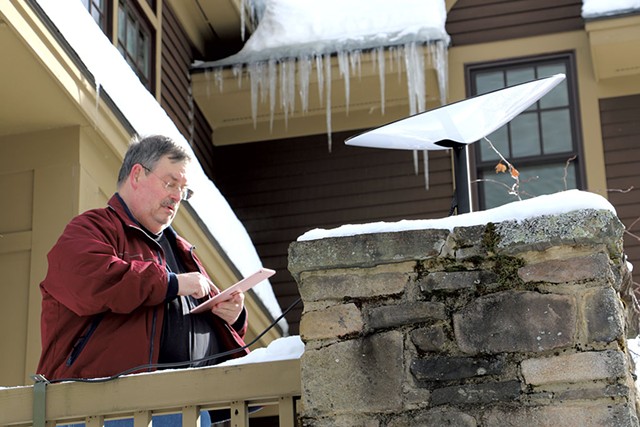
- Kevin Mccallum ©️ Seven Days
- Dennis Roland with his new Starlink satellite internet dish
When Dennis Roland retired to the hills outside Waterbury in 2014, he knew part of the price of a slower pace of life would be slower internet service.
He didn't know it would practically cost him his sanity.
As a chemist at a New Jersey pharmaceutical company, Roland had been used to collaborating with colleagues around the world using lightning-fast internet services. But from his new home at the end of an unpaved road in the Worcester Range, Roland's connection was agonizingly slow — when he had it at all.
"It would go out for a couple weeks at a time, which drove me nuts!" Roland exclaimed.
His spotty data stream trickled in from a wireless antenna atop Ricker Mountain, several miles to the west. Despite his home's clear line of sight to the peak, the service — even after it improved under a new provider — lagged. An episode of "Game of Thrones" took three hours to download. Videos on newspaper websites or YouTube buffered endlessly. And his sons could forget about online gaming.
For several years, he listened as Vermont politicians promised "universal broadband" and service providers predicted blazing speeds in the future. By 2020, he was tired of waiting.
"Getting fiber optic here in Vermont is probably years away, as far as I can tell," Roland said.
So when he learned that Tesla entrepreneur Elon Musk's SpaceX rocket company had launched high-speed internet service relying on a network of mini-satellites circling the globe, he quickly got on board. He joined the waiting list for Starlink's beta service late last year, so-called because the company acknowledged it was still working out the kinks. He learned he'd been approved in early January, paid his $580 setup fee and got a satellite dish in the mail a few weeks later. He plunked the sleek, white disk on a corner of his snowy porch, which offers a clear view of the sky above Mount Mansfield. He ran the cord through a window and started tearing up the web.
"It was so darn simple to set up. It literally took me 15 minutes," Roland said.
The prospect of Starlink high-speed internet service is thrilling to rural residents such as Roland, who have found themselves on the wrong side of the state's digital divide.
The pandemic has highlighted these disparities — and made addressing them more urgent — as more people work from home and kids go to school online. An estimated 70,000 households in Vermont don't have access to broadband internet service, according to a 2019 study.
But the pandemic has also brought an infusion of millions of federal dollars that Vermont can invest to improve rural internet service. Now, policy makers must decide: What are the best technological and business models to ensure that high-speed internet service reaches all Vermont households?
Should public money go to existing, often for-profit, service providers that have so far failed to extend broadband to all the households in their territory? Or should it go to new, relatively untested providers such as Starlink and the growing number of communications districts being created by groups of towns around Vermont?
Last year the state pledged $20 million in federal pandemic relief funds for broadband access, though it wasn't able to spend it all by the end of the year as required.
Vermont offered assistance to people who couldn't afford the internet services already available to them. The state also awarded about $12 million to broadband providers to make faster internet service available to about 10,000 new households.
In addition, the Federal Communications Commission has granted $32.5 million to providers to extend service to 19,000 addresses in Vermont over the next six years, according to the Department of Public Service. Starlink's share is $3.9 million to provide internet and voice services to 2,247 underserved locations over the next 10 years.
That's far less funding than established players were granted. Telephone and broadband company Consolidated Communications was awarded $19 million. Two communications union districts, ECFiber in east-central Vermont and Kingdom Fiber in northeastern Vermont, won a combined $9.5 million. Gov. Phil Scott has said he'd like to see another $20 million spent on broadband next year.
Though smaller and relatively unproven compared to its competitors, Starlink has one clear advantage. It can reach rural communities without any of the expensive earthbound investments that have been the largest obstacle to broadband expansion in hilly, sparsely populated parts of the state.
To reach new customers, fiber or television cable providers have to spend millions to string lines to homes. Cellular telephone networks must invest in more powerful antennas. And wireless internet service providers, such as the one that served Roland's home, need to stake out new ground on often crowded, distant hilltops.
Starlink rises above all those hurdles with a network of more than 1,000 satellites put into low Earth orbit by SpaceX's reusable rocket system. It has reported more than 10,000 global subscribers in just its first few months of operation. While Starlink won't say how many Vermont residents have signed up, the service clearly has the potential to shake up the broadband landscape, according to Clay Purvis, director of telecommunications for the state public service department.
"I think SpaceX is for real here, because they have taken so much federal money in exchange for deploying broadband," Purvis said.
When the company first considered providing service to Vermont, Starlink representatives wanted to make sure, Purvis said, that there would be at least 30 paying customers per "cell" — a hexagon-shaped zone approximately the size of two towns. "Our response was: In Vermont, people are gonna be murdering each other in the street for an opportunity to be one of those 30 to 50 people," Purvis said. "I don't think you have to worry about that."
The service was initially available only in the northern third of the state, but Starlink has said it expects to expand statewide. The company, which just launched 60 new satellites this week, is now signing up customers.
"Are we going to lose a few customers to Starlink? Sure," said Luc Beaubien, managing member of New Hampshire-based New England Wireless, the internet service that provides about 10 megabits per second of download speed to Roland, which is better than it once was but still frustrates him.
Starlink is providing speeds five to 16 times faster than that, Roland said. Once the test phase is over, if Starlink proves reliable, Roland said, he'll keep its $99-a-month service and cancel his $75-a-month New England Wireless contract.
A longer-term but arguably more pressing question is what impact Starlink might have on lawmakers' efforts to steer more money and responsibility for universal broadband to communications districts.
Inspired by the success of ECFiber in bringing broadband to underserved towns in east-central Vermont, there are now 11 communications districts looking to replicate the model. The districts are created when at least two towns join forces and create an independent municipal entity. Such districts can't raise taxes, but they can issue revenue bonds to pay for communications infrastructure.
The House Energy and Technology Committee is considering a bill this week that would strengthen the authority of and steer future funding to such districts. If an effective, statewide satellite broadband solution such as Starlink materializes to serve rural areas, it could upend that model, or at least make it harder for the public districts to succeed, Purvis said.
"If the [communications districts] show up after Starlink has a foothold in the market, they may not see, at least initially, the take-rate they want," Purvis said.
Lawmakers, too, fret that grants to existing providers could allow them to pick off the profitable customers in a geographic area, leaving only the more-expensive-to-serve remainder for the newly formed districts.
Rep. Tim Briglin (D-Thetford), who chairs the House committee, said it is important to support the union districts because they are the most likely to provide the best long-term solution: fiber to every home.
Briglin doubts that Starlink will undermine communications districts' prospects, he said. "It remains to be seen how well the technology performs at scale, as Starlink's subscribers increase from hundreds of Vermonters to thousands of Vermonters and to millions of people across the country," he wrote in an email.
Starlink's arrival will likely force other providers who can't compete on speed to focus on attributes such as price, reliability and customer service, Purvis said.
The threat Starlink poses to current providers is nevertheless limited, Beaubien of New England Wireless said. There are significant cost and technological hurdles the service would have to overcome for it to enjoy significant market penetration, he said. "Am I concerned to the point where it will threaten our existence and business model? No," he said.
While some folks in Waterbury may be willing to spend nearly $600 up front plus $99 per month for broadband alone, that's a little rich for most Vermonters' blood, Beaubien said. His company offers high-speed internet and phone for as low as $65 per month.
There are significant geographic limitations, as well. Starlink customers currently need a clear view of the northern sky, something many rural residents lack. And the company's technology, while impressive, is still in development and could experience growing pains, noted Tom Evslin.
The semiretired internet technology entrepreneur lives in the hills southeast of Stowe and pays for two traditional internet service providers, neither of which delivers the speed and reliability he needs.
Evslin ordered Starlink, received his dish in the mail, set it up and marveled as the device automatically searched the sky for signals from the parade of satellites. He even blogged a video of the dish doing its thing.
While he is captivated by Starlink's potential, it's got issues. During a Zoom call with a reporter, Evslin's image froze several times, a hiccup caused when his dish lost connection with a passing satellite before picking up the feed from the one behind it a few seconds later.
The service is nevertheless a vast improvement, he said, and the state ought to consider subsidizing it for people who need it now. Any service from the communications district in his area is years off, he added.
"I don't think people can wait that long," Evslin said. "The urgency was really there before the pandemic, but the pandemic has certainly shown us how urgent their need is."
Because Starlink regularly adds new satellites and bandwidth, Evslin thinks it can complement the work of communications districts, offering a needed service now while the districts pursue their long-term broadband plans.
"We keep telling ourselves the need is right now — so let's put that money into what we can get right now," Evslin said.














Comments
Comments are closed.
From 2014-2020, Seven Days allowed readers to comment on all stories posted on our website. While we've appreciated the suggestions and insights, right now Seven Days is prioritizing our core mission — producing high-quality, responsible local journalism — over moderating online debates between readers.
To criticize, correct or praise our reporting, please send us a letter to the editor or send us a tip. We’ll check it out and report the results.
Online comments may return when we have better tech tools for managing them. Thanks for reading.